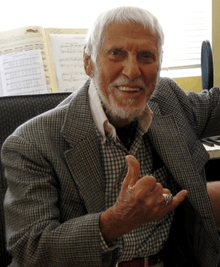Bill Tapia
| Bill "Tappy" Tapia | |
|---|---|
 Uncle Bill "Tappy" Tapia in 2007 | |
| Background information | |
| Birth name | William Tapia |
| Born |
January 1, 1908 Honolulu, Hawaii, U.S. |
| Died |
December 2, 2011 (aged 103) Los Angeles, California, U.S. |
| Genres | Jazz, Hawaiians |
| Occupation(s) | Singer, Musician |
| Years active | 1918–2011 |
| Associated acts | Bing Crosby, Louis Armstrong, Elvis Presley |
| Website | BillTapia.com |
| Notable instruments | |
| Ukulele, guitar, lap steel | |
William "Bill" Tapia (January 1, 1908 – December 2, 2011), known as "Uncle Bill" and "Tappy", was an American musician, born to Portuguese parents. At age 8, Tapia was already a professional musician, playing “Stars and Stripes Forever” for World War I troops in Hawaii.
In his long career beginning in vaudeville and quickly expanding as a jazz guitarist and ukulele player he performed with names such as Bing Crosby, Louis Armstrong, Elvis Presley and Hawaiian musicians such as King Bennie Nawahi, Sol Ho‘opi’i, and Andy Iona. Despite his long life, Tapia did not record any music until 2004 when he put out his first CD at the age of 96. On March 23, 2004, he provided a detailed interview for the NAMM oral history collection about his impressive career and life in music. He recalled designing several instruments for many of his luthier friends as well as improvement and adjustments to the uke he had over the years.
He continued to perform and record at an advanced age, all the while remaining in vigorous health and driving a car until his 100th birthday when he began suffering eyesight problems.
Tapia was a featured performer in Mighty Uke: The Amazing Comeback of a Musical Underdog, a 2010 documentary on the ukulele.
Tapia died in his sleep on December 2, 2011 a month short of turning 104.[1]
Discography
- Tropical Swing, 2004
- Duke of Uke, 2005
- Livin' It Live, 2009
- Young At Heart: Japan Live, 2009
- Live Warner Grand Theatre: 100th Birthday Concert, 2009
External links
| Wikimedia Commons has media related to Bill Tapia. |
- Interview with Uncle Bill Tapia - Part I - Free internet podcast featuring interview with Uncle Bill Tapia (part 1).
- Interview with Uncle Bill Tapia - Part II - Free internet podcast featuring interview with Uncle Bill Tapia (part 2).
- Uncle Bill Tapia Official Home Page
- Brief article on the life of Bill Tapia
- Award-winning PBS documentary film about Bill Tapia: "To You Sweetheart, Aloha"
- ↑ "Ukulele legend Bill Tapia dies at 103 - Entertainment - Music - TODAY.com". Today.msnbc.msn.com. 2011-11-28. Retrieved 2011-12-03.
- Interview with Bill Tapia NAMM Oral History Library (2004)